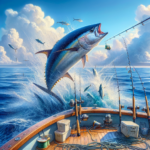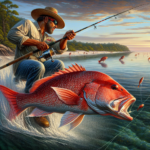Permit Fishing in the Florida Keys

Introduction
Imagine casting your line into the crystal-clear waters of the Florida Keys, feeling the tug of a powerful fish, and reeling in a prized permit. This scenario is a dream come true for many anglers, and the Florida Keys offer one of the best locations in the world for permit fishing. This article will delve into the intricacies of permit fishing in the Florida Keys, covering everything from the best techniques and gear to the top fishing spots and seasonal considerations. Whether you’re a seasoned angler or a novice, this guide will provide valuable insights to enhance your fishing experience.
Permit fishing in the Florida Keys is not just a pastime; it’s a revered tradition that attracts anglers from around the globe. Understanding the nuances of this sport can significantly improve your chances of success and ensure a memorable fishing adventure.
Background/Context
Historical or Cultural Significance
The Florida Keys have long been a hotspot for fishing enthusiasts, with a rich history dating back to the early 20th century. The region’s unique ecosystem and abundant marine life have made it a premier destination for sport fishing. Permit, in particular, are highly sought after due to their elusive nature and the challenge they present to anglers.
Geographical Overview
The Florida Keys are a coral cay archipelago located off the southern coast of Florida, stretching over 120 miles from Key Largo to Key West. The region boasts a tropical climate, with warm temperatures year-round and a diverse marine ecosystem. The shallow flats, mangroves, and coral reefs provide an ideal habitat for permit and other game fish.
Key Points/Details
Fishing Techniques
Technique Overview
Permit fishing in the Florida Keys primarily involves sight fishing on the flats. This technique requires anglers to spot the fish in shallow waters and cast their bait or fly accurately. Fly fishing and spin fishing are the two most common methods used.
When and Where to Use
Sight fishing is best done during low tide when the water is clear, and the fish are more visible. The flats around Key West, Marathon, and Islamorada are particularly productive. Early morning and late afternoon are the optimal times for permit fishing, as the fish are more active during these periods.
Recommended Gear
- Rods: A 9-foot, 8-10 weight fly rod for fly fishing; a 7-8 foot medium-heavy spinning rod for spin fishing.
- Reels: High-quality reels with a smooth drag system to handle the powerful runs of permit.
- Lines: Floating fly lines for fly fishing; 10-20 lb braided line for spin fishing.
- Bait/Lures: Crab and shrimp patterns for fly fishing; live crabs, shrimp, and artificial lures for spin fishing.
Species Information
Species Overview
Permit (Trachinotus falcatus) are a highly prized game fish known for their strength and speed. They are typically found in shallow coastal waters, especially around sandy flats, reefs, and mangroves. Permit are known for their keen eyesight and wariness, making them a challenging target for anglers.
Best Practices
To successfully catch permit, it’s essential to approach them quietly and cast accurately. Use light tackle to avoid spooking the fish and present your bait or fly naturally. Patience and persistence are key, as permit can be selective feeders.
Location Information
Top Fishing Spots
- Key West: Known for its extensive flats and clear waters, Key West is a top destination for permit fishing.
- Marathon: Offers a variety of fishing environments, including flats, channels, and reefs.
- Islamorada: Famous for its productive flats and experienced fishing guides.
- Lower Keys: Less crowded and offers excellent opportunities for sight fishing.
Regulations and Licenses
Anglers must have a valid Florida fishing license to fish in the Keys. There are specific regulations regarding the size and bag limits for permit. As of the latest regulations, the daily bag limit is one permit per person, with a minimum size limit of 22 inches fork length. Always check the latest regulations from the Florida Fish and Wildlife Conservation Commission (FWC) before your trip.
Seasonal Considerations
Seasonal Variations
Permit fishing in the Florida Keys is productive year-round, but certain seasons offer better conditions. Spring and fall are considered the best times, as the water temperatures are ideal, and the fish are more active. Summer can also be productive, but anglers should be prepared for hot weather and afternoon thunderstorms.
Best Times to Fish
The optimal times for permit fishing are early morning and late afternoon when the fish are most active. Tides also play a crucial role; fishing during a rising or falling tide can increase your chances of success.
Events and Tournaments
Event Overview
The Florida Keys host several fishing tournaments throughout the year, including events specifically for permit. The March Merkin Permit Tournament in Key West is one of the most prestigious, attracting top anglers from around the world.
Preparation Tips
To prepare for a tournament, practice your casting accuracy and familiarize yourself with the local fishing spots. Ensure your gear is in top condition and pack extra supplies. Study the tournament rules and regulations to avoid any disqualifications.
Tips and Best Practices
General Tips
- Practice your casting accuracy to improve your chances of landing a permit.
- Use polarized sunglasses to spot fish more easily in the water.
- Stay patient and persistent, as permit can be elusive and challenging to catch.
Avoid Common Mistakes
- Avoid making loud noises or sudden movements that can spook the fish.
- Don’t use heavy tackle, as it can make your presentation less natural and scare away permit.
- Ensure your knots are secure to prevent losing fish due to tackle failure.
Advanced Techniques
- Master the double haul cast for greater distance and accuracy in fly fishing.
- Learn to read the water and identify potential permit habitats.
- Experiment with different fly patterns and lures to find what works best in various conditions.
Gear and Equipment Recommendations
Essential Gear
- 9-foot, 8-10 weight fly rod or 7-8 foot medium-heavy spinning rod.
- High-quality reel with a smooth drag system.
- Floating fly lines or 10-20 lb braided line.
- Crab and shrimp patterns for fly fishing; live crabs, shrimp, and artificial lures for spin fishing.
- Polarized sunglasses for better visibility.
Optional Gear/Upgrades
- Waterproof camera to capture your catches.
- Fishing gloves for better grip and protection.
- Portable fish finder to locate schools of permit.
Where to Buy or Rent
Local tackle shops in the Florida Keys, such as Angler’s Pro Shop in Key West and Florida Keys Outfitters in Islamorada, offer a wide range of gear for purchase or rent. Online stores like Bass Pro Shops and Cabela’s also provide extensive selections of fishing equipment.
Safety and Conservation
Safety Tips
- Always check the weather forecast before heading out and be prepared for sudden changes.
- Wear sunscreen, a hat, and protective clothing to shield yourself from the sun.
- Stay hydrated and bring plenty of water.
- Be aware of local wildlife, including jellyfish and stingrays, and know how to handle encounters safely.
Conservation Practices
- Practice catch and release to help preserve the permit population.
- Handle fish gently and minimize their time out of the water.
- Follow all local fishing regulations and respect protected areas.
- Dispose of trash and fishing line properly to protect the environment.
Planning Your Trip
Accommodations
The Florida Keys offer a range of accommodations, from luxury resorts to budget-friendly motels. Popular options include the Ocean Key Resort & Spa in Key West, Hawks Cay Resort in Duck Key, and Cheeca Lodge & Spa in Islamorada.
Travel Tips
The Florida Keys are accessible by car via the Overseas Highway (U.S. Route 1). Key West International Airport and Miami International Airport are the nearest major airports. Renting a car is recommended for exploring the area and reaching various fishing spots.
Additional Activities
When you’re not fishing, the Florida Keys offer plenty of other activities, including snorkeling, scuba diving, kayaking, and exploring local attractions like the Ernest Hemingway Home and Museum in Key West and the Dolphin Research Center in Marathon.
Frequently Asked Questions (FAQs)
What is the best time of year for permit fishing in the Florida Keys?
Spring and fall are considered the best times for permit fishing, as the water temperatures are ideal, and the fish are more active. However, permit can be caught year-round in the Keys.
Do I need a fishing license to fish for permit in the Florida Keys?
Yes, a valid Florida fishing license is required to fish for permit in the Florida Keys. Be sure to check the latest regulations from the Florida Fish and Wildlife Conservation Commission (FWC).
What type of gear is best for permit fishing?
A 9-foot, 8-10 weight fly rod or a 7-8 foot medium-heavy spinning rod is recommended. Use high-quality reels with a smooth drag system, floating fly lines or 10-20 lb braided line, and crab and shrimp patterns for fly fishing or live crabs, shrimp, and artificial lures for spin fishing.
Are there any local fishing tournaments for permit in the Florida Keys?
Yes, the Florida Keys host several fishing tournaments, including the prestigious March Merkin Permit Tournament in Key West.
Conclusion
Permit fishing in the Florida Keys offers an exhilarating and rewarding experience for anglers of all skill levels. By understanding the best techniques, gear, and locations, you can significantly improve your chances of success. Remember to practice conservation and safety measures to ensure a sustainable and enjoyable fishing adventure. Whether you’re planning a dedicated fishing trip or participating in a local tournament, the Florida Keys provide an unparalleled setting for permit fishing. So pack your gear, head to the Keys, and get ready for an unforgettable fishing experience.




